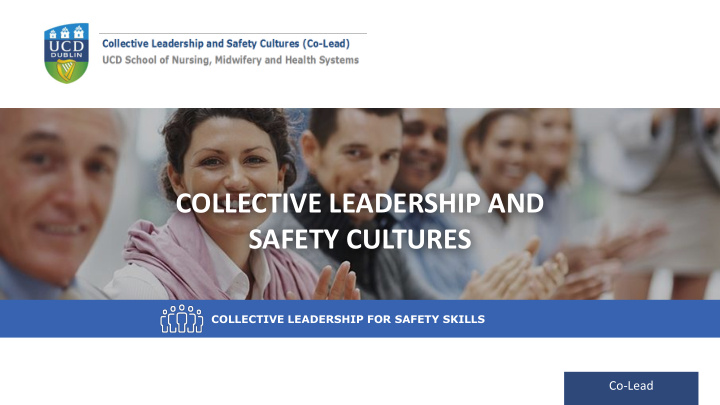



COLLECTIVE LEADERSHIP AND SAFETY CULTURES COLLECTIVE LEADERSHIP FOR SAFETY SKILLS Co-Lead
Coll llective responsibility • Collective responsibility is the notion that if each individual in a team can effect the team’s results, we can attribute the successes and failures of the team to every individual. • Collective responsibility asserts that if an error occurs or a patient is harmed each individual involved — including patients, healthcare professionals and managers — is responsible for that failure. • This sense of collective responsibility improves patient safety and helps to build a culture of safety in healthcare systems.
Coll llectively Id Identify fying the causes of f errors Biases in seeking causes People have cognitive biases that prevent them from seeing causes. Some examples: • Confirmation bias prefers causes that agree with our initial assumptions. • Ingroup bias prefers causes that implicate people outside our close associates. • Sunk cost bias shuns causes that involve expensive investments. • Recency illusion can prefer causes that have become recently visible, but were present and hidden before. • The bandwagon effect prefers causes that other people mention.
T-shaped professionals • Collective responsibility motivates the development of broadly skilled colleagues. • The concept of T-shaped professionals or T-shaped skills is one where the vertical bar on the T represents the depth of related skills and expertise in a single field or discipline, whereas the horizontal bar is the ability to collaborate across disciplines with experts in other areas and to apply knowledge in areas of expertise other than one's own. • T-shaped professionals have well-developed specialty skills and broad capabilities in other areas. Broader skills in a group are important for taking collective responsibility
Sa Safety Sk Skills and Competencies The Six Domains of Safety Competencies 1. Contribute to a culture of patient safety 2. Work in teams for patient safety 3. Communicate effectively for patient safety 4. Manage safety risks 5. Optimise human and environmental factors 6. Recognise, respond to and disclose adverse events Ref : Ginsburg L, Castel E, Tregunno D , et al. The H-PEPSS: an instrument to measure health professionals' perceptions of patient safety competence at entry into practice. BMJ Qual Saf 2012; 21: 676-684.
Team Team skills Factor Item priority (1-10) ranking Managing inter-professional conflict Working in teams Sharing authority, leadership and decision-making with other Encouraging team members to speak up, question, challenge, advocate and be accountable professionals as appropriate to address safety issues Enhancing patient safety through clear and consistent communication with patients Communicating Enhancing patient safety through effective communication with other healthcare providers effectively Effective verbal and nonverbal communication abilities to prevent adverse events Recognising routine situations in which safety problems may arise Managing Safety risks Identifying and implementing safety solutions Anticipating and managing high risk situations Understanding Human Understanding the role of human factors, such as fatigue, which effect patient safety and Environmental Understanding the role of environmental factors such as work flow, ergonomics and factors resources, which effect patient safety Recognise and Recognising an adverse event or close call respond to reduce Reducing harm by addressing immediate risks for patients and others involved harm Taking a questioning attitude and speaking up when I see things that may be unsafe Creating a supportive environment that encourages patients and providers to speak up when they have concerns about safety Culture of Safety Understanding the nature of systems (e.g., aspects of the organisation, management or the work environment including policies, resources, communication and other processes) and system failures and their role in adverse events
Outcome template PRIORITY AGREED ACTIONS TO DEVELOP RESPONSIBLE DATE TO REVIEW SAFETY SKILL RANKING THIS SKILL WITHIN OUR TEAM PERSON(S) PROGRESS 1 2 3 4 5
Recommend
More recommend